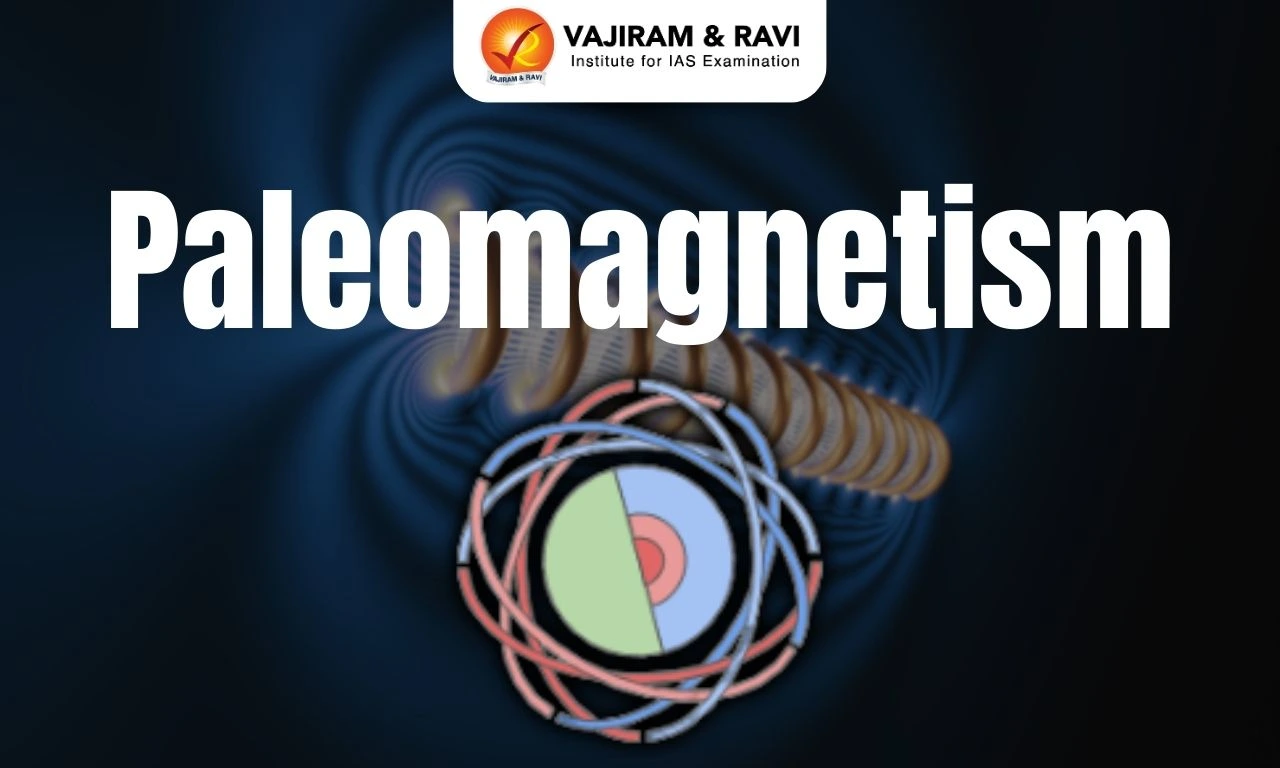The concept of palaeomagnetism was first introduced by French physicist Bernard Brunhes in 1906 to explore how volcanic rocks capture Earth’s magnetic field direction upon cooling. The Earth’s magnetic field is like a giant bar magnet that is slightly tilted from its rotational axis. It has north and south poles determined by the field line’s entry and exit points.
Remarkably, the polarity of this field can be reversed, swapping the north and south poles. Magnetic minerals in rocks, such as magnetite, align with the magnetic field below the Curie temperature, causing the field’s direction and intensity to be preserved at the time of formation.
How Does Paleomagnetism Work?
Palaeomagnetism analyses the remnant magnetization of rocks caused by changes in the earth’s magnetism over time. This remnant magnetization refers to the permanent magnetization that rocks acquire as they cool and solidify from molten material or undergo chemical changes at low temperatures.
Paleomagnetism Significance
The study of paleomagnetism not only helps us to understand the various geographical phenomena that happened in the past but with its study, we can make certain future geographical predictions.
- Predictions about the Earth’s magnetic field change: It helps in understanding the past variations in Earth’s magnetic field, which include countless reversals and flips (like polar wandering). By studying this, we can make informed predictions about the field’s future behaviour.
- To understand the earth’s evolution: The study of palaeomagnetism is also known as fossil magnetism. It is an important source of information about the earth’s evolution over time. Many rocks have kept this record since they were formed.
- Evidence supporting the plate tectonics theory: Paleomagnetism provides strong data supporting the hypothesis of plate tectonics. It records how magnetic minerals in the oceanic crust, particularly iron-rich basalt, align with the magnetic field, particularly along mid-ocean ridges, preserving the magnetic field’s alignment at the time of formation.
- Documentation of magnetic field: It provides a detailed account of the direction of the Earth’s magnetic field, with many rocks retaining this information since their origin.
- Dating rocks and fossils: Paleomagnetism can help date the origin of rocks, and magnetic reversals serve as a time scale for dating fossils found in certain rock layers.
Paleomagnetism: Earth’s Magnetism, Sea Floor Spreading and Plate Tectonics
Rocks contain tiny magnetic minerals that align themselves with the Earth’s magnetic field when they form. By studying the orientation of these minerals, scientists can reconstruct the past positions of continents and the history of the Earth’s magnetic field. Hence, palaeomagnetism acts as a proof for theories like seafloor spreading and plate tectonics.
| Concept | Description |
| Earth magnetism | – Paleomagnetism is crucial for understanding the earth’s magnetic field behaviour over geological timelines.
|
| Sea-floor spreading | – The theory of sea-floor spreading describes how magma rises at mid-ocean ridges, solidifies to form a new oceanic crust and aligns its minerals with the Earth’s magnetic field.
|
| Plate tectonics | – Plate tectonics theory, which states that the Earth’s outer shell is divided into several plates gliding over the mantle, is supported by palaeomagnetism and sea-floor spreading evidence.
|
Paleomagnetism UPSC PYQs
Consider the following:
- Electromagnetic radiation
- Geothermal energy
- Gravitational force
- Plate movements
- Rotation of the earth
- Revolution of the earth
Which of the above are responsible for bringing dynamic changes on the surface of the earth? (UPSC Prelims 2013)
- 1, 2, 3 and 4 only
- 1, 3, 5 and 6 only
- 2, 4, 5 and 6 only
- 1, 2, 3, 4, 5 and 6
Answer: (d)
Last updated on April, 2025
→ UPSC Notification 2025 was released on 22nd January 2025.
→ The UPSC Vacancy 2025 were released 1129, out of which 979 were for UPSC CSE and remaining 150 are for UPSC IFoS.
→ UPSC Admit Card 2025 is expected to release in first week of May for CSE Prelims Exam 2025.
→ The UPSC Prelims 2025 is scheduled to be conducted on 25th May 2025 and UPSC Mains 2025 will be conducted on 22nd August 2025.
→ Apply once through it and aspirants can apply for various government exams conducted by UPSC.
→ The UPSC Selection Process is of 3 stages-Prelims, Mains and Interview.
→ UPSC Result 2024 is released with latest UPSC Marksheet 2024. Check Now!
→ UPSC Toppers List 2024 is released now. Shakti Dubey is UPSC AIR 1 2024 Topper.
→ Also check Best IAS Coaching in Delhi
Paleomagnetism FAQs
Q1. What is palaeomagnetism?+
Q2. How does palaeomagnetism work?+
Q3. Why is palaeomagnetism significant?+
Q4. How does palaeomagnetism support the theories of sea-floor spreading and plate tectonics?+
Tags: Paleomagnetism quest















